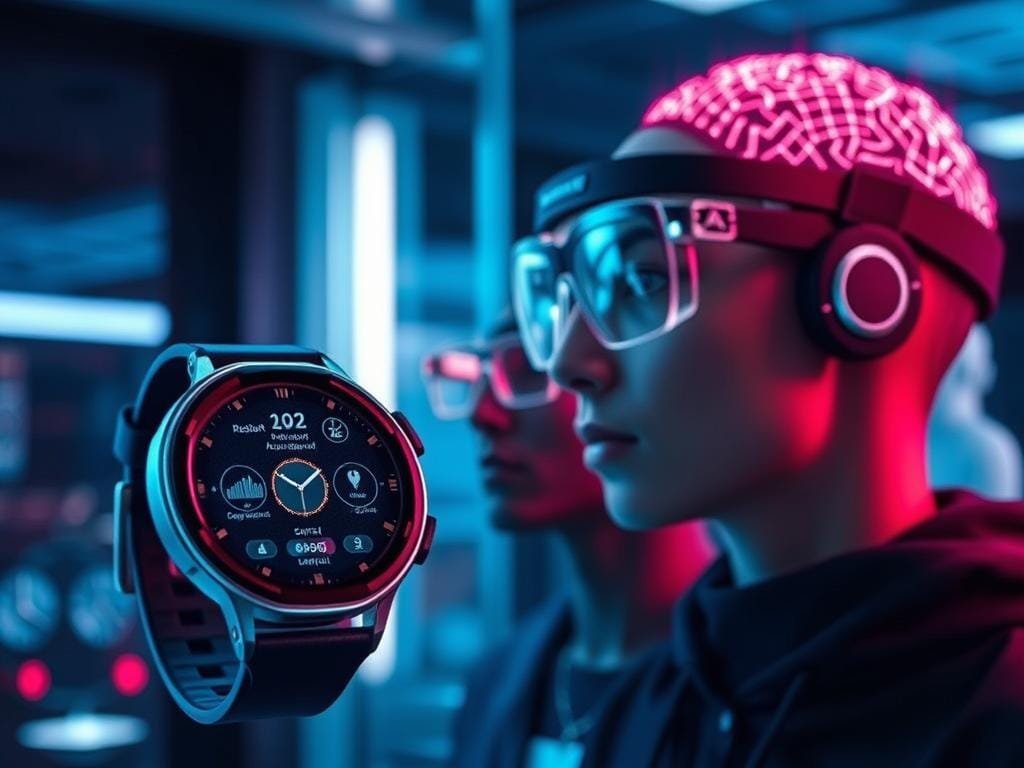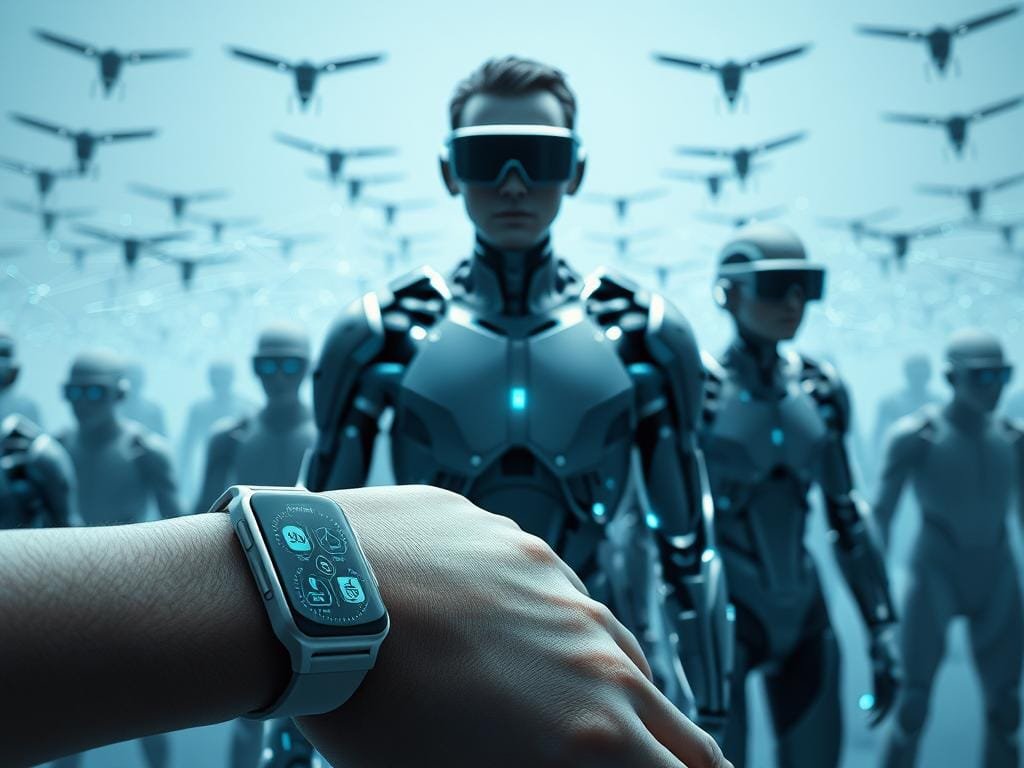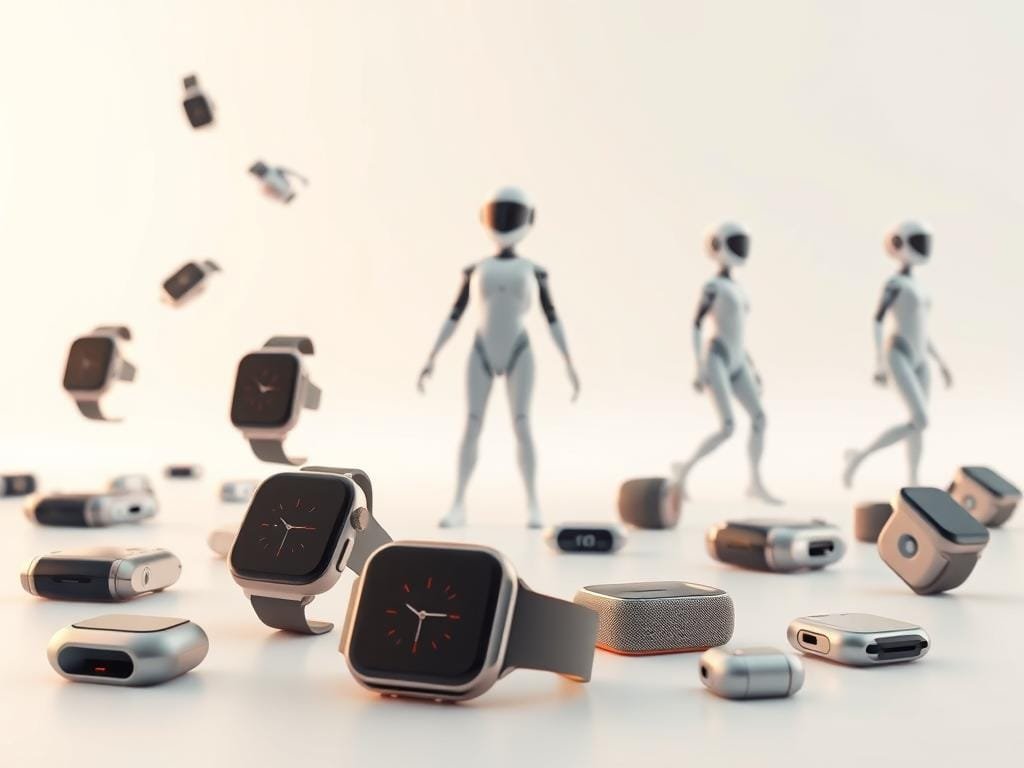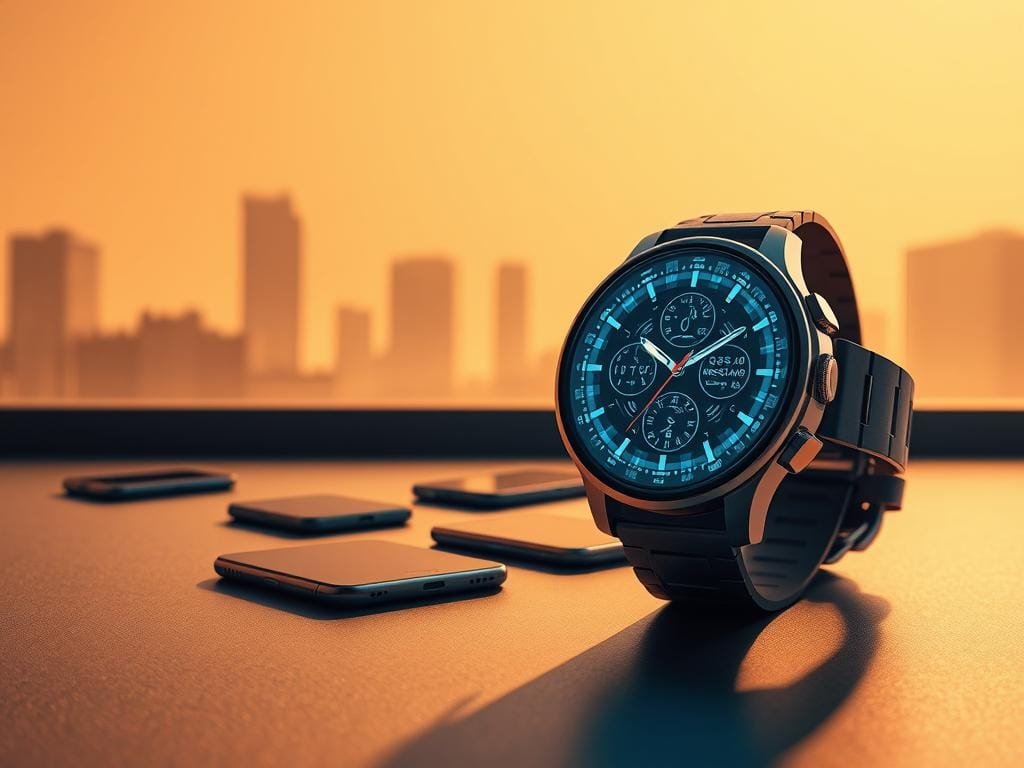Wearable technology is not new, but AI-powered wearables are changing how we use them. Smartwatches can predict health issues, and AR glasses translate languages in real-time. Artificial intelligence is making wearables smarter.
These devices are becoming key parts of our daily lives. They use machine learning to learn from data and offer tailored experiences. This change is not just about tech; it’s also opening up new areas in healthcare, finance, and more.
Key Takeaways
- AI-powered wearables are revolutionizing the tech world with their innovative capabilities.
- These devices are becoming essential in our daily lives, providing personalized experiences.
- Machine learning integration enables wearables to process data and improve efficiency.
- New possibilities are emerging in various sectors, including healthcare and finance.
- The future of wearable technology is closely tied to advancements in AI.
Understanding the Shift from Smartphones to Wearables
The move from smartphones to wearables is more than a trend. It’s a big change in technology. We need to know why this change is happening.
The Evolution of Mobile Technology
Mobile tech has grown a lot. The first cellular phone was big and simple. Now, we have smartphones that are small and do a lot. Now, we’re seeing a big change with wearables.
Limitations of Traditional Smartphones
Smartphones are handy but have downsides. They can be too much to handle, always needing our attention. They also don’t always meet our immediate needs.
Consumer Demand for Enhanced Connectivity
People want better connectivity and a more personal experience. Wearables give us real-time info and help us manage our health and digital life easily.
| Feature | Smartphones | Wearables |
|---|---|---|
| Primary Use | Communication, Entertainment | Health Monitoring, Notifications |
| User Interaction | Touchscreen, Voice | Voice, Gestures, Touch |
| Portability | High | Very High |
The wearable AI market in healthcare is set to hit $169 billion by 2029. This shows a big move towards health monitoring that’s personal and connected. It’s not just about gadgets. It’s about giving people more control, better care, and quick answers.
What Are AI-Powered Wearable Devices?
AI in wearable devices is changing how we use mobile tech. These devices are not just simple accessories. They are smart companions that learn from your data and meet your needs.
Defining AI in Wearable Tech
AI in wearable tech means these devices can analyze data and learn from you. They use complex algorithms to process info from sensors like heart rate monitors and GPS. For example, new advancements have made smartwatches that can spot health problems and warn you.
Types of Wearable Companions
Wearable companions come in many forms, each with its own purpose. Here are some common ones:
- Smartwatches: These are well-known for tracking fitness and managing notifications.
- Biosensors and Wearable Patches: They monitor vital signs and help with health tracking.
- Smart Rings and Clothes: These devices track health metrics in a discreet way.

Key Features of AI Wearables
AI wearables are known for their learning and adapting abilities. Some key features include:
| Feature | Description | Benefit |
|---|---|---|
| Health Monitoring | Continuous tracking of vital signs and health metrics. | Early detection of health issues. |
| Personalized Recommendations | AI-driven suggestions based on user behavior and preferences. | Enhanced user experience through tailored advice. |
| Seamless Integration | Compatibility with various devices and platforms. | Convenience and ease of use across different ecosystems. |
To learn more about how 5G technology boosts AI wearables, check out the latest in mobile tech.
Benefits of Using AI-Powered Wearables
AI-powered wearables do more than just track your health. They change your lifestyle for the better. These smart devices offer personal assistance and health monitoring.

Improved Health Monitoring Capabilities
AI wearables have changed health tracking. They monitor vital signs and spot early disease signs. For example, they track heart rate and blood pressure.
They can even find health issues before they become big problems. Recent studies show they’re making healthcare better by giving real-time health data.
These devices also offer personalized fitness coaching. They analyze your activity and sleep to help you reach your health goals. This makes your fitness journey more effective.
Enhanced Personal Assistance Features
AI wearables are more than health trackers. They act as smart personal assistants. They provide real-time meeting transcriptions, reminders, and notifications.
They learn your preferences and adjust their help. This makes your day more organized and focused.
They also make controlling other smart devices easy. This seamless integration boosts your productivity and simplifies your digital life.
Seamless Integration with Daily Life
AI wearables fit perfectly into your daily routine. They help you track fitness, get important alerts, and control your smart home. All with just a glance or voice command.
Adding AI wearables to your life makes it more efficient. As tech advances, these devices will keep improving our daily lives.
Popular AI Wearable Companions on the Market
Technology keeps getting better, and AI-powered wearables are becoming more popular. These devices make our lives better by being more personal and interactive.
Smartwatches: The Leading Innovators
Smartwatches are everywhere now, thanks to Apple and Samsung. They let you check your health and manage messages right from your wrist.
- Health Monitoring: Track your heart rate, sleep patterns, and exercise routines.
- Notification Management: Receive and respond to messages, emails, and calls.
- Personalized Insights: Get customized recommendations based on your daily activities.

Fitness Trackers: Your Personal Health Coach
Fitness trackers have grown beyond just counting steps. They now track your health closely, helping you stay fit.
- Monitor your daily activity and set fitness goals.
- Track your nutrition and hydration levels.
- Receive alerts for unusual heart rate activity.
Smart Glasses: A Look at the Future
Smart glasses are the latest in tech, making it easy to see and interact with info. Google is leading the way, making glasses that work without your hands.
- Augmented Reality: Experience interactive information overlays.
- Voice Control: Manage your device with voice commands.
- Capture photos and videos hands-free.
In conclusion, AI wearables are changing how we use tech. Smartwatches, fitness trackers, and smart glasses offer a more personal and fun way to interact with the world.
Comparing AI Wearables to Smartphones
AI wearables are becoming more popular, and it’s important to know how they compare to smartphones. As technology gets better, it’s easier to see how different devices are similar and different. We need to look at what each device does best.

Versatility vs. Specialization
Smartphones can do lots of things, like talk, play games, and help you work. AI wearables, though, focus on one or two main tasks. They might track your health or help with daily tasks.
Smartphones can do many things at once. But AI wearables are great at what they do. For example, a smartwatch can track your heart rate and workouts better than a smartphone.
- Smartphones: General-purpose devices capable of handling a variety of tasks.
- AI Wearables: Specialized devices that focus on specific functions, enriching user experience in those areas.
User Experience and Interaction
How you use AI wearables and smartphones is different. Smartphones need you to touch or type on them. AI wearables, though, often use voice commands or gestures. This makes them easier to use quickly.
For instance, you can ask your smartwatch to remind you of something or check the weather without touching it. This is really helpful when you’re busy or your hands are full.
- Voice commands for quick information or actions.
- Gesture controls for navigating through menus or options.
- Simplified interfaces tailored to the device’s specific functions.
Battery Life and Portability
Battery life is a big difference between AI wearables and smartphones. Smartphones need to do lots of things, so they have bigger batteries. But they often need to be charged every day. AI wearables have smaller batteries but use less power.
Many AI wearables can go several days without needing to be charged. This makes them great for long workouts or all day use without needing to recharge.
Portability is also important. AI wearables are made to be worn, so they’re always with you. Smartphones are portable too, but they might not be as easy to get to as a wearable on your wrist.
The Role of AI in Personalization
AI plays a key role in making wearables personal. They learn from what you do and change to fit your needs. This makes using them more natural and meaningful.
Customized User Experience
AI wearables study how you act and what you like. They use this info to give you a customized user experience. This means they can offer better and more personal help.
- Personalized fitness plans based on your activity levels and goals.
- Customized notifications that filter out irrelevant information.
- Adaptive interfaces that adjust to your preferred settings and interactions.
Experts say AI personalization is more than just data. It’s about knowing what you need and giving you experiences that matter. (Source)
Predictive Analytics for User Behavior
Predictive analytics is a big part of AI in wearables. They look at past data and current trends to guess what you’ll do next.
- Anticipating your daily routine to adjust settings proactively.
- Predicting health metrics to provide early warnings or recommendations.
- Forecasting your needs based on your schedule and preferences.
This helps make the device more ready and able to meet your needs.
Advanced Notifications and Alerts
AI wearables are also great at sending advanced notifications and alerts. They know what you like and when, so they send you the right info at the right time.
“The future of wearables lies in their ability to understand and respond to the user’s needs proactively, making AI a critical component of this technology.” (Source)
In summary, AI in wearables is changing how we experience personalization. It makes devices more tailored, intuitive, and ready for us. As AI gets better, we’ll see even more advanced wearables that really get us.
Challenges Facing Wearable Technology
Wearable devices have many benefits but also face several challenges. It’s important to understand these challenges to make sure they work well in our daily lives.
Privacy and Data Security Concerns
One big challenge is privacy and data security. Wearables collect a lot of personal data, like health info and location. It’s key to keep this data safe from hackers.
A report showed many wearables don’t have strong security. This makes them easy targets for data breaches.
“The increasing dependence on wearable technology raises significant concerns about data privacy and security. As these devices become more pervasive, the data breaches and misuse of personal information grow.”
Technological Limitations and Usability
Wearable tech also has tech limits and usability issues. Many devices have short battery life and are small, which limits their use. For example, smartwatches have tiny screens that make some tasks hard.
Improving battery life and making devices easier to use are key for makers.
| Technological Limitation | Description | Potential Solution |
|---|---|---|
| Battery Life | Limited battery life hinders continuous use. | Advancements in battery technology or power-saving features. |
| Screen Size | Small screens limit functionality and user experience. | Improved display technology or alternative interaction methods. |
| Data Accuracy | Inaccurate data can lead to misinformation. | Enhanced sensor technology and data validation algorithms. |
Market Adoption and Consumer Education
Getting more people to use wearable tech is a challenge. The market is growing, but people need to know more about these devices. Many don’t understand their full capabilities or how to use them every day.
In conclusion, wearable tech faces many challenges, but solving these can make devices better and safer. As tech keeps improving, these issues will likely get better, leading to more people using and benefiting from wearables.
The Future of Wearables in Your Digital Life
Wearable technology is on the verge of a big change, thanks to AI. We need to look at the new trends that will change the wearables world.
Emerging Trends in AI Technology
AI is making wearables smarter. Predictive analytics and natural language processing are leading the way. A study on PMC shows how these technologies are improving wearable devices.
Wearables will soon be able to guess what you want and suggest things. They do this by using complex algorithms to understand your habits and needs.
Predictions for the Next Five Years
In the next five years, wearables will be even more part of our lives. Here’s what we can expect:
- More advanced health monitoring features
- Increased use of augmented reality
- Greater integration with other smart devices
| Feature | Current Status | Predicted Status in 5 Years |
|---|---|---|
| Health Monitoring | Basic vital sign tracking | Advanced predictive health analytics |
| Augmented Reality | Limited interactive experiences | Seamless integration into daily activities |
| Smart Device Integration | Basic connectivity | Complex automation and control |
Integration with Smart Home Devices
The future of wearables also means more connection with smart home devices. Imagine controlling your home’s lights, temperature, and security with your wrist or voice. This will make our homes more responsive to our needs.
As wearables evolve, they will be key in our digital lives. They will help us manage our routines, stay connected, and enjoy a more personalized experience.
Conclusion: Embracing a Wearable Future
As we look ahead, finding a balance between ease and usefulness in AI wearables is key. With 72% of U.S. homes now using smart devices, the global market is set to grow. It will focus on blending into our daily lives smoothly. You can learn more about this trend in the rise of ambient computing.
Convenience Meets Functionality
Understanding how wearables can improve your life is the first step. They can save 63% of time on home tasks, making life easier. But, it’s important to pick ones that really fit your needs.
Making an Informed Choice
When picking a wearable, think about what you need. Do you want better health tracking or more personal help? Picking the right device is key for a good experience.
Next Steps in Adoption
Before diving into wearables, look at what’s out there and how they’ll fit into your life. This way, you can choose wisely, balancing ease and usefulness for a better lifestyle.
FAQ
What are AI-powered wearable devices?
AI-powered wearable devices are smart gadgets you wear, like smartwatches or fitness trackers. They use artificial intelligence to offer health monitoring, personal help, and manage notifications.
How do AI-powered wearables differ from traditional smartphones?
AI-powered wearables focus on specific tasks, like health tracking or notification management. Smartphones, on the other hand, are more versatile and can do many things.
What are the benefits of using AI-powered wearables?
They offer better health monitoring, personal assistance, and easy integration into daily life. This makes it simpler to stay connected and manage your day.
Are AI-powered wearables secure?
There are privacy and data security concerns with AI-powered wearables. But, many makers are working to fix these issues with strong security and encryption.
Can AI-powered wearables be used with my existing smartphone or smart home devices?
Yes, many AI-powered wearables work well with smartphones and smart home devices. This makes it easy to connect your wearable to your current setup.
How do I choose the right AI-powered wearable for my lifestyle?
Think about what you need, like health tracking or notification management. Then, look for devices that fit your needs.
What is the future of AI-powered wearables?
The future will bring new AI tech, like better machine learning and natural language processing. We’ll see more integration with smart homes and other devices.
Are AI-powered wearables compatible with different operating systems, such as iOS and Android?
Many AI-powered wearables work with iOS and Android. But, always check the device’s compatibility before buying to ensure it fits with your setup.






